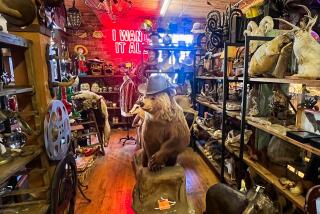Cinerama Dome puts ‘How the West Was Won’ in proper perspective
At 9:30 on a recent Wednesday morning, projectionist John Sittig is stationed in the darkened, submarine-like projection room of the Cinerama Dome at the ArcLight Hollywood. Flanked by whirring machinery, he and his crew are monitoring three synchronized 1961 movie projectors, a vintage sound dubber and 85,000 feet of film (that’s 16 miles).
In the theater below, a panoramic view of a rustic homestead fills the Dome’s expansive curved screen, which is 86 feet wide and 32 feet high. The picture is pristine, save for two faint vertical lines dividing the image into thirds.
Sittig is conducting a test screening of the 1962 epic “How the West Was Won,” which will play Sunday morning in its original Cinerama format as part of the third annual TCM Classic Film Festival. The sprawling drama stars John Wayne, Henry Fonda, James Stewart and Debbie Reynolds (who will attend Sunday) and tells the story of a family of pioneers taming the American West over 60 years.
Directed by John Ford, Henry Hathaway and George Marshall, “How the West Was Won” is one of only two narrative features (along with “The Wonderful World of the Brothers Grimm”) created using the ambitious, innovative “three-strip” Cinerama process, which combined three images horizontally to create a super-wide picture simulating the natural range of human vision.
“This was the Imax of the ‘50s and ‘60s,” Sittig says. Noting Cinerama’s extreme depth of focus, he adds, “The picture is so sharp, from 2 feet to 2 miles.... There’s nothing else like it.”
Shown on a curved screen and accompanied by seven channels of stereo sound, Cinerama offered an immersive experience when the popularity of movies was stagnating and television was on the rise.
“There was a need for something different, certainly,” says David Strohmaier, a film editor and Cinerama historian.
Cinerama movies were shot on three strips of 35-millimeter film at once, using a specialized camera with three lenses and three film magazines. One strip each was dedicated to the left, center and right portion of the final image. Live audio was recorded on a rig holding a number of microphones at regular intervals; a boom mike might also be used to capture dialogue.
Playing a Cinerama film requires three projectors, with each one projecting an image that fills a third of the screen. The seams where the images overlap are visible, though photographic techniques and the design of the projectors can help disguise the lines. A fourth film strip provides the sound.
The first Cinerama films focused on spectacle rather than storytelling and were often styled as travelogues. Segments might include a tableau-like recording of a dance performance, a flyover of the Grand Canyon or a point of view shot of a roller coaster ride.
The films were hits, so attempting a traditional narrative in Cinerama was inevitable, though the format was not well suited to studio filmmaking. The camera was cumbersome, and its lack of a through-the-lens viewfinder made precise framing difficult. Actors had to hit their marks accurately to avoid straddling two panels, and they had to cheat their eye lines, looking slightly to one side or another of their intended target so their glances wouldn’t appear skewed on the curved screen.
“It was hell to work with from the Hollywood crew’s side,” Strohmaier said. Showing a Cinerama film is equally complex. The three projectors and the sound dubber are mechanically linked, but multiple projectionists — Sunday’s screening will use five — must constantly adjust the alignment of the composite image. And with so many moving parts, there are more opportunities for something to go wrong.
“You’re using four different pieces of film, four different pieces of equipment,” Sittig says, “and if one of them is off by one frame or two frames, it ruins the entire show.”
During the test run, a film strip breaks and the sound goes out of sync. Sittig is not flustered. In his 10 years showing Cinerama films at the Dome, he has never had one fail in front of an audience.
Though successful at the box office, Cinerama was supplanted in the ‘60s by less complicated single-strip 70 mm formats, which had lower resolution but presented fewer logistical concerns. Today the Cinerama Dome, which was renovated in 2002, and the Seattle Cinerama, renovated in 1998, are the only theaters in the U.S. capable of playing three-strip Cinerama.
Sunday’s show marks the TCM festival’s first Cinerama screening. Genevieve McGillicuddy, the festival’s managing director, says the organizers have wanted to include Cinerama from the event’s inception. “We always love to try to bring whatever that unique experience is to our audiences,” she says.
Although true Cinerama is indeed unique these days, its legacy is ubiquitous.
“Today any time you turn on your TV set, it’s a wide-screen image and it’s multiple channels of sound,” Strohmaier says. “That all started with Cinerama.”
‘How the West Was Won’
Where: Cinerama Dome at the ArcLight Hollywood
When: 9:15 a.m. Sunday
Running time: 2 hours, 42 minutes, plus intermission
Price: $20
Info: https://www.tcm.com/festival
More to Read
The biggest entertainment stories
Get our big stories about Hollywood, film, television, music, arts, culture and more right in your inbox as soon as they publish.
You may occasionally receive promotional content from the Los Angeles Times.






